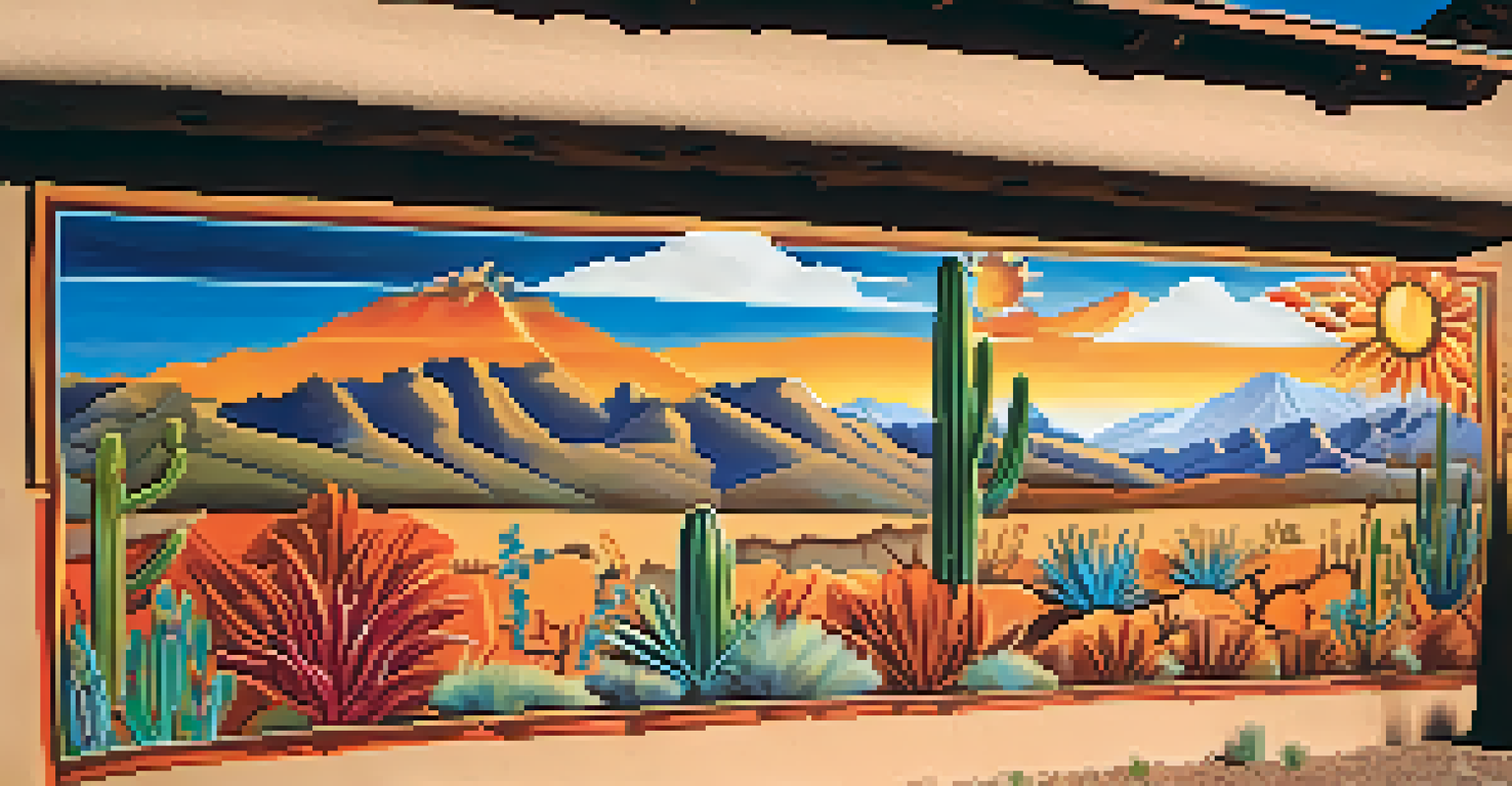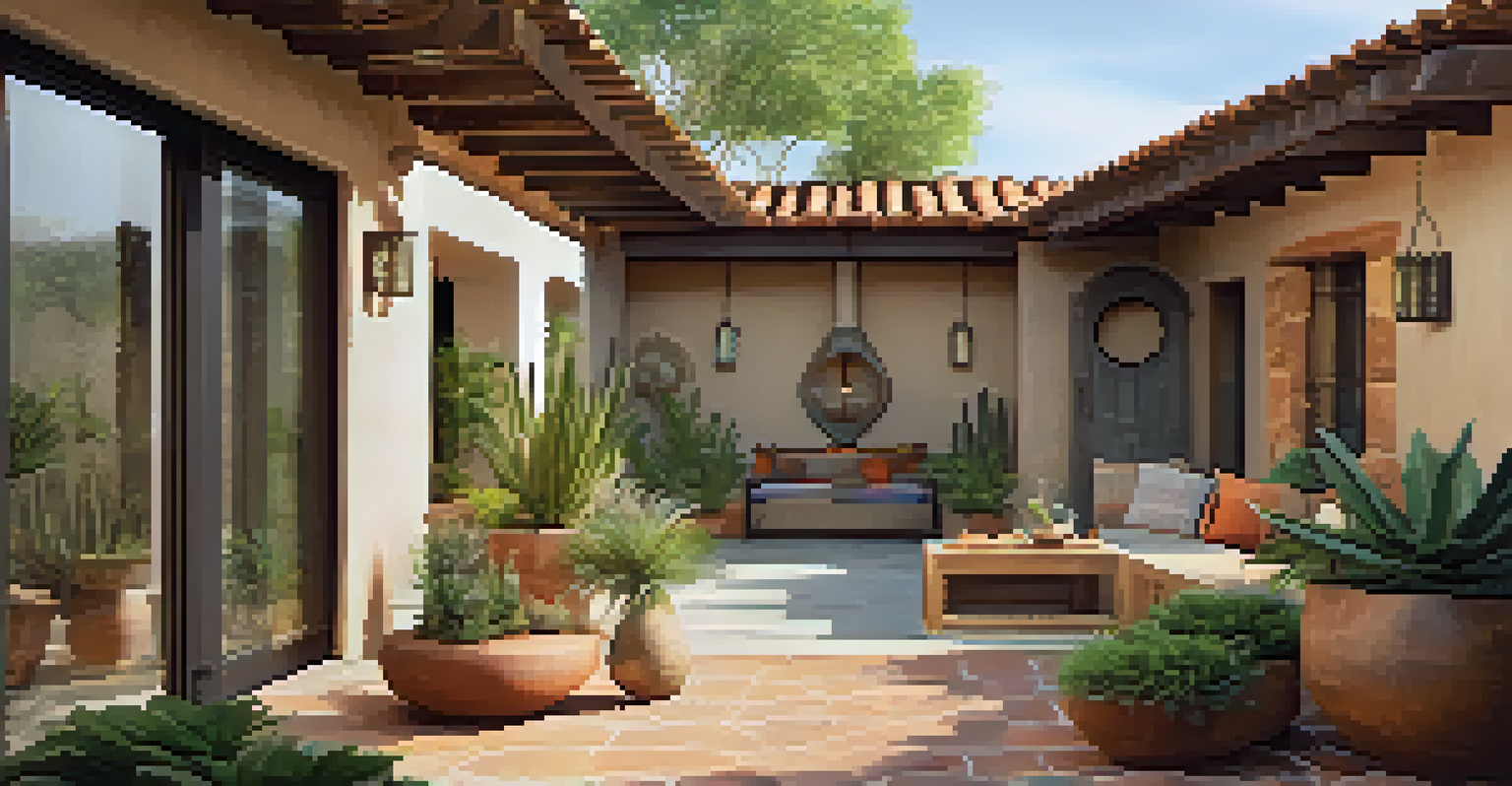Exploring Tucson's Adobe Homes: A Cultural Architectural Legacy

Understanding the Origins of Adobe Architecture
Adobe architecture has deep roots that date back centuries, primarily influenced by Indigenous peoples and Spanish settlers. Tucson's adobe homes exemplify a blend of these cultures, showcasing the adaptability and resourcefulness in using local materials. The sun-baked bricks, made from clay and straw, reflect the region's climate and have been a practical choice for insulation against the desert heat.
Adobe architecture is a testament to the harmony between nature and shelter, built on a foundation of cultural history and environmental respect.
These structures are not just homes; they represent a harmonious relationship between nature and shelter. Historically, adobe homes provided comfort and protection while also allowing for natural ventilation, an essential feature in the warm Tucson climate. This architectural style speaks to a time when communities were built around sustainable living and respect for environmental elements.
Today, the legacy of adobe architecture continues to inspire modern builders and homeowners. Many are drawn to the aesthetic appeal and eco-friendliness of adobe homes, recognizing their historical significance. This revival of interest ensures that Tucson's architectural heritage remains a vital part of its cultural landscape.
The Unique Characteristics of Adobe Homes
Adobe homes are easily recognizable by their thick walls, rounded corners, and earthy tones that blend seamlessly into the desert surroundings. These characteristics not only serve aesthetic purposes but also functional ones, helping to keep interiors cool in the summer and warm in the winter. The natural materials used in adobe construction contribute to a unique texture and warmth that many find inviting.

Another distinctive feature of adobe homes is their layout, often designed to maximize airflow and natural light. Many structures include interior courtyards, providing a private outdoor space that connects residents with nature. This design encourages a communal lifestyle, fostering connections among family and friends.
Cultural Roots of Adobe Architecture
Adobe architecture in Tucson reflects a rich blend of Indigenous and Spanish influences, showcasing sustainable building practices rooted in local materials.
Additionally, the use of local materials extends beyond just the adobe bricks. Many homes incorporate wooden beams, tile roofs, and colorful accents that reflect the culture and history of the region. Each home tells a story, showcasing the craftsmanship and creativity of builders who have passed down their skills through generations.
Cultural Significance of Tucson's Adobe Homes
The adobe homes of Tucson are more than just structures; they are cultural landmarks that celebrate the city's rich history. These homes embody a fusion of Native American, Spanish, and Mexican influences, representing the diverse ancestry of the region. As such, they serve as a reminder of Tucson's unique cultural heritage and the stories of the people who have lived there.
The future of adobe architecture lies in the balance between honoring tradition and embracing innovation.
Throughout the years, these homes have played a pivotal role in community life, often becoming the backdrop for gatherings, celebrations, and traditions. Their enduring presence in Tucson's neighborhoods fosters a sense of identity and belonging among residents. Preserving these architectural treasures is essential for maintaining the city's cultural narrative.
In recent years, the local government and various organizations have worked to promote awareness and appreciation for adobe architecture. Initiatives aimed at preserving these homes ensure that future generations can experience the rich history and cultural significance they represent. This dedication to heritage reflects a community committed to honoring its past while embracing the future.
Modern Adaptations of Adobe Homes
While traditional adobe homes are cherished, modern adaptations have emerged that blend historical charm with contemporary design. Architects and builders are finding innovative ways to incorporate adobe techniques into new constructions, creating homes that are both energy-efficient and stylish. These modern adobe homes often feature open floor plans, large windows, and sustainable materials, appealing to today's homeowners.
The resurgence of interest in eco-friendly building practices has brought adobe back into the spotlight. Many are drawn to its natural insulating properties, which reduce energy consumption and promote sustainability. This movement aligns with a growing awareness of environmental issues, making adobe homes a popular choice for those looking to lessen their carbon footprint.
Modern Innovations in Adobe Homes
Contemporary adaptations of adobe homes combine traditional techniques with modern design, emphasizing energy efficiency and environmental sustainability.
Moreover, these modern adaptations often maintain the essence of traditional adobe architecture while catering to contemporary lifestyles. Homeowners can enjoy the benefits of a timeless design without sacrificing comfort or functionality. This blend of old and new keeps the spirit of Tucson's adobe homes alive in a rapidly changing world.
Exploring Tucson's Adobe Neighborhoods
Tucson is home to several neighborhoods where adobe architecture flourishes, each with its own unique character. Areas like Barrio Viejo and El Presidio showcase a rich collection of adobe homes that tell the story of the city's evolution. Walking through these neighborhoods feels like stepping back in time, as the charm of adobe structures captivates visitors and residents alike.
Barrio Viejo, in particular, is known for its vibrant colors and artistic flair, with many homes adorned with murals and intricate details. This neighborhood has become a canvas for local artists, reflecting the community's creative spirit. Exploring these streets offers a glimpse into Tucson's artistic heritage, making it a popular destination for both tourists and locals.
El Presidio, on the other hand, focuses on preserving the historical aspects of adobe architecture. Here, visitors can find guided tours that highlight the significance of these homes and the stories behind them. Engaging with the local history adds depth to the experience, allowing everyone to appreciate the cultural richness of Tucson's adobe legacy.
Preservation Efforts for Adobe Homes
Preserving Tucson's adobe homes is crucial for maintaining the city’s architectural diversity and cultural heritage. Various organizations and community groups are dedicated to advocating for the protection and restoration of these structures. Their efforts ensure that future generations can enjoy the beauty and history of adobe homes.
One of the primary challenges in preserving these homes is the need for ongoing maintenance, as adobe can be susceptible to weathering and erosion. Preservation efforts often involve community engagement, educating residents about proper care techniques and the importance of maintaining their homes. This collaborative approach fosters a sense of ownership and pride among community members.
Preservation of Tucson's Heritage
Efforts to preserve adobe homes are vital for maintaining Tucson's cultural identity, involving community engagement and support from local governments.
Additionally, local governments play a vital role in supporting preservation through policies and funding initiatives. By promoting awareness and providing resources, they help to safeguard Tucson's architectural legacy. These combined efforts create a supportive environment where adobe homes can thrive and continue to tell their stories for years to come.
The Future of Adobe Architecture in Tucson
As Tucson moves forward, the future of adobe architecture looks promising, with a growing interest in sustainable building practices. More people are recognizing the benefits of adobe construction, not only for its energy efficiency but also for its cultural significance. This shift towards environmentally conscious living aligns with broader trends in architecture that prioritize sustainability and heritage.
The integration of modern technologies and traditional adobe techniques offers exciting possibilities for the future. Innovative builders are experimenting with new materials and methods while preserving the essence of adobe structures. This creative approach ensures that adobe architecture remains relevant and appealing to future homeowners.

Ultimately, the future of Tucson's adobe homes lies in the balance between honoring tradition and embracing innovation. By fostering a culture of appreciation and respect for this architectural legacy, the community can ensure that these homes continue to thrive and inspire for generations to come. The journey of adobe architecture in Tucson is far from over; it is evolving, much like the vibrant city itself.